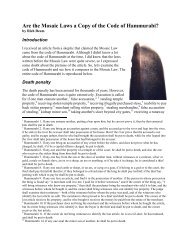Coming to Grips with the Early Church Fathers - Evidence for God ...
Coming to Grips with the Early Church Fathers - Evidence for God ...
Coming to Grips with the Early Church Fathers - Evidence for God ...
You also want an ePaper? Increase the reach of your titles
YUMPU automatically turns print PDFs into web optimized ePapers that Google loves.
<strong>Coming</strong> <strong>to</strong> <strong>Grips</strong> <strong>with</strong> <strong>the</strong> <strong>Early</strong> <strong>Church</strong> Fa<strong>the</strong>rs’ Perspective on Genesis John Millam<br />
his<strong>to</strong>ry would encompass exactly 6,000 years. This would be followed by a seventh millennial<br />
“day” (paralleling <strong>the</strong> Sabbath rest) that <strong>the</strong> church identified <strong>with</strong> Christ’s millennial kingdom.<br />
After this is <strong>the</strong> start of <strong>the</strong> “eighth day,” which marks <strong>the</strong> inauguration of <strong>the</strong> new creation. 35<br />
Mook documents that at least eight fa<strong>the</strong>rs seem <strong>to</strong> have taught this millennial framework. 36<br />
Robert Bradshaw, a young-earth creationist, also provides an extensive discussion of this view<br />
and includes additional names. 37<br />
The exact origin of this model is uncertain but it seems <strong>to</strong> have arisen in Jewish circles perhaps a<br />
century or two be<strong>for</strong>e Jesus’ time. It’s likely that this model developed, at least partially, out of<br />
<strong>the</strong> apocalyptic ferment of <strong>the</strong> time. With Israel under <strong>the</strong> control of <strong>the</strong> Greeks and later <strong>the</strong><br />
Romans, apocalyptic literature emphasized <strong>God</strong>’s sovereign control over all things—including<br />
his<strong>to</strong>ry. Having a clear <strong>for</strong>mula <strong>for</strong> when <strong>God</strong> would act on behalf of his people encouraged<br />
faithfulness amid such chaotic times.<br />
This particular six-thousand-year framework was popular among Jewish rabbis, who fur<strong>the</strong>r<br />
subdivided it in<strong>to</strong> three 2,000-year periods: <strong>the</strong> age of chaos, <strong>the</strong> age of <strong>the</strong> law, and <strong>the</strong> age of<br />
<strong>the</strong> Messiah. 38 To put this in context, some early Jewish sources placed creation around 4000<br />
BC. 39 Using that as a start point, <strong>the</strong> age of <strong>the</strong> law would have begun <strong>with</strong> Abraham around<br />
2000 BC and <strong>the</strong> Messiah would inaugurate <strong>the</strong> messianic age in <strong>the</strong> early first century. For <strong>the</strong><br />
apocalyptic writers of <strong>the</strong> first and second century BC living under <strong>for</strong>eign domination, <strong>the</strong><br />
promise of <strong>the</strong> Messiah coming soon <strong>to</strong> rescue <strong>the</strong>m was enormously encouraging. Thus, this<br />
framework was popular even though it was not derived from a literal interpretation of Scripture.<br />
Christians later adopted this model. Since <strong>the</strong> church used <strong>the</strong> Greek Septuagint instead of <strong>the</strong><br />
Hebrew text, <strong>the</strong>y generally thought creation occurred around 5600–5500 BC. 39 The church <strong>the</strong>n<br />
used <strong>the</strong> creation week framework <strong>to</strong> predict Christ’s return on <strong>the</strong> six thousandth year (ra<strong>the</strong>r<br />
than his coming on <strong>the</strong> four thousandth, as <strong>the</strong> Jewish rabbis had taught). The seventh<br />
millennium (paralleling <strong>the</strong> Sabbath rest) was identified <strong>with</strong> Jesus’ millennial kingdom. All of<br />
this had important escha<strong>to</strong>logical implications because it predicted that <strong>the</strong> end times would be<br />
around <strong>the</strong> fourth century.<br />
Starting <strong>with</strong> Eusebius in <strong>the</strong> fourth century, <strong>the</strong> date <strong>for</strong> creation was revised <strong>to</strong> around 5200<br />
BC, pushing Christ’s return back three hundred years. Apparently, this was done <strong>to</strong> cool<br />
35. The idea of <strong>the</strong> “eighth day” seems <strong>to</strong> be drawn mainly from a misunderstanding of <strong>the</strong> headers of Psalms 6 and<br />
12. The Hebrew word sheminith is likely a musical term but was translated “eighth” in <strong>the</strong> Greek Septuagint as<br />
used by <strong>the</strong> church fa<strong>the</strong>rs. In addition, Jesus’ resurrection on <strong>the</strong> first day of <strong>the</strong> week could also be viewed as<br />
an eighth day (i.e., <strong>the</strong> first day of <strong>the</strong> second week) and so prefigured <strong>the</strong> new creation on <strong>the</strong> eighth day.<br />
36. James Mook, “The <strong>Church</strong> Fa<strong>the</strong>rs on Genesis, <strong>the</strong> Flood, and <strong>the</strong> Age of <strong>the</strong> Earth,” 40–48. According <strong>to</strong> my<br />
own study, 11 out of <strong>the</strong> 50 church fa<strong>the</strong>rs and 2 out of <strong>the</strong> 30 Jewish sources taught this framework. John<br />
Millam, “The Genesis Genealogies.”<br />
37. Bradshaw, chapter 3, table 3.2.<br />
38. Bradshaw, chapter 3.<br />
39. There were a number of attempts <strong>to</strong> date back <strong>to</strong> creation using <strong>the</strong> genealogies of Genesis 5 and 11. The ages at<br />
fa<strong>the</strong>rhood in <strong>the</strong>se genealogies as given in <strong>the</strong> Greek Septuagint were noticeably older than <strong>the</strong> actual values<br />
given in <strong>the</strong> Hebrew text. Using <strong>the</strong> Septuagint, <strong>the</strong> early church arrived at distinctly different estimates<br />
compared <strong>to</strong> Jews following <strong>the</strong> Hebrew. In <strong>the</strong> end, <strong>the</strong>se age estimates are not rigorous and rely on a lot of<br />
assumptions, and are, <strong>the</strong>re<strong>for</strong>e, should not be used in attempts <strong>to</strong> determine <strong>the</strong> age of <strong>the</strong> earth. For complete<br />
documentation and analysis, see John Millam, “The Genesis Genealogies.”<br />
Page 12 <strong>Evidence</strong> <strong>for</strong> <strong>God</strong> from Science






